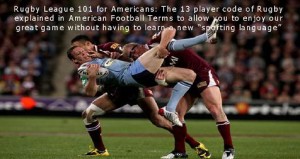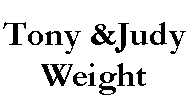Rugby League is an exciting, powerful game, played by powerful athletes who experience more than 300 collisions during 80 minutes of play! Those of you who are new to the sport may find the following description helpful in understanding the game.

RUGBY LEAGUE: There are 2 codes of Rugby: Rugby Union, which most of the USA refers to as Rugby; and Rugby League, which severed from Rugby Union in the 1800s and is the code we play. Although Rugby League and Union are similar, it is easier to equate League into American Football terms due to the use of defined plays that are grouped into sets of 6 tackles (Set of 6 Downs), and each play starting with a “play the ball” (Snap). To save you the confusion of the unfortunate “names” of our sport. We suggest you think about LEAGUE as the 13 player code, and UNION as the 15 player code.
You may find it helpful to play this video after reading to understand some of the explanations – CLICK HERE FOR VIDEO
THE TEAMS: Each team has 13 players on the field at one time. Players do not leave the field at change of possession; therefore all players play both offense and defense. Although each player has a “position” you can refer to each player as a forward or a back. Forwards are usually the bigger guys that pound the ball much like a running back, while the backs are used in more set plays, like receivers in diverse wildcat formations with multiple passes of the ball. While most players play the entire 80 minutes, substitutions are made throughout the game for various reasons, such as injury, fatigue, or strategy.
THE GAME: Like football, the game is started with a kick-off. The team with possession then has 6 tackles (downs) to score. Providing they do not lose the ball or commit a rule infraction, most sets of tackles will be used with 5 plays being run and then a kick on the 6th play for better field position. This is referred to as a “completion” of the set. Unlike football, the ball must be passed either laterally or backwards at all times. A forward pass is an infraction that will result in a penalty to the other team if deemed deliberate, or a scrum if deemed accidental. You also cannot “Block” other players, so defensive players have unrestricted access to the ball carrier. It is essentially 13 players who must be running backs in offense, and linebackers in defense, and they play no huddle, hurry up offense for the entire game.
THE OFFENSE: After each tackle on offense, the ball carrier must get to his feet as quickly as possible and “play the ball” (Snap) by putting the ball on the ground and rolling it back with one foot. He essentially becomes the “Center” for that play. The person who picks the ball up from the “play the ball” (Snap) is essentially the Quarterback for that play. We refer to this action as being the “Dummy Half” or “Acting Half”, usually filled by the “Hooker” for most plays, but can be any player in offense. He picks up the ball and either runs (Quarterback Sneak) or passes the ball (hand off) to start the next play. Once the ball is picked up, the defense can advance. If the team has not scored after five plays (Downs), they usually kick for field position if far from their try line (end zone), or as a final attacking play if they are close to the try line. Offense players are eligible to gather the kicked ball if they are behind the kicker at the time of the kick (on side), and advance until tackled or a try is scored. If they are tackled on the 6th Tackle the ball possession is turned over to the other team.
THE DEFENSE: Two defenders are allowed line up directly in front of the tackled player, in the “Marker” position (similar to two defensive linemen) but they must stand “in-line” with the two offensive players during the “play the ball.” The “Marker Role” is typically filled by any player(s) who have been involved in the tackle. Once the ball has been played, these “Markers” may move and attempt to tackle the Dummy Half (quarterback) or the next ball carrier. The remaining defensive players must stay 10 yards back from the “play the ball” (line of scrimmage), until the ball has been picked up from the “Dummy Half” position. They can only move forward from that line once the “play the ball” occurs. The Forwards usually stay close to the “play the ball” area as they use their physical size to counteract the momentum of the offensive forwards. Meanwhile, the Backs line up wider to counteract the speed and evasive moves performed by the offensive Backs (similar to keeping your linemen near the play to cover a running back and putting your defensive backs wider to cover speed and skill from a wide receiver or tight end).
OBJECTIVE DURING PLAY: A tackle is only effected when the player is secured on the ground (effectively held), or being dominated with backward momentum. With defense having to advance and retreat 10 yards for every play (down) to be “on side”, the advantage for the ball carrier is to land on his front during the tackle so he can quickly get to his feet and “play the ball” (snap) in an effort to create less organized defense, and tire them with constant movement. Defense counters by trying to get the tackled player on his back (Turtle him) so that he is slowed down with the “play the ball”(snap) and gives the defensive line more time to organize. This constant battle in every tackle is tough on all players, and basic wrestling technique is part of weekly preparation. Defense is exhausting, so completing “Sets of 6 Downs” is key in offense, as it is a players only chance to recover during the game. A combination of designed plays in each “Set”, targeting specific parts of the field with ball movement, and strategic kicks are used to maximize offensive advantage and tire defenses as much as possible. The average set of plays (6 downs) should be completed in no more than 90 seconds. Defense can counter with dominant tackling that puts ball carriers on their back and makes them have to fight to gain their feet, that slows the “play the ball” (snap) and tires them during offense. As a rule, there should be some amount of discomfort for the ball carrier during every tackle, and he should have to fight from being flipped onto his back. The play ends when the referee verbally states the play is over, usually by yelling “Held” or stating the actual tackle number (down).
SCORING
Try (touchdown) = 4 points, occurs when a player touches the ball to the ground inside the try zone (end zone); merely breaking the try zone plane with the ball does not count.
Conversion (extra points) = 2 points, occurs when the ball is kicked between the goal posts after a try. The kick, by an accomplished kicker, must be taken with the ball placed on the ground (place kick) directly back from the point where the try was awarded. For this reason, it’s an advantage for the Try Scorer to place the ball as close to the goal posts as possible before being tackled.
Drop Goal = 1 point, can be taken at anytime during regular play. The ball is first dropped to the ground on its point and kicked simultaneously (drop kicked) between the goal posts.
Penalty Kicks = 2 points, occurs when certain fouls allow for a “kick at goal” that allows the team to kick for penalty points from the spot of the foul. Teams can also choose to kick the ball “in to touch” (Out of bounds) and restart play with a new set of tackles (downs) at that point for field advantage. This decision is determined based on field position, current score, and other factors that are believed to give the best scoring opportunity.
PENALTIES AND INFRACTIONS: Although there are many ways for play to be stopped, it can be broken down into 2 categories.
Unintentional rule infractions, including, but not limited to, a “knock on” (a fumble that causes the ball to go forward and then re-gathered by the offensive team), an accidental “forward pass,” or allowing the ball to travel into touch (out of bounds). These types of infractions will result in a scrum, which is when the defensive team will be given the “feed” (they put the ball into the scrum) and usually acquire possession.
Deliberate rule infractions, include, but are not limited to, high tackles (those that make contact above the shoulder of the ball carrier), being off side in defense (inside the 10 yards during the play the ball), malicious attacking of another player, and holding a tackled player down longer than allowed. This will result in the team that is awarded the penalty to kick the ball into touch (out of the field of play) for field position and then restart a new set of 6 tackles at that point, or for extra points with a penalty kick at goal.
TERMS SECTION
PLAY THE BALL – (Snap) Similar to a snap in the NFL by initiating play. When the ball carrier is tackled or stopped from moving forward, he stands up and places the ball on the ground and rolls it back with his foot, so the “dummy half” can pick it up and pass or run with the ball.
40/20 RULE – (Field position kick) A rule that if a player manages to bounce a kick in general play from inside his own 40 yard line, into touch (out of bounds) inside his opponents 20 yard area. This gives the offense possession and 6 more tackles in an attacking position. Kicks that are not 40/20 that go “into touch” (out of bounds) result in the opposing team getting position with scrum feed.
KNOCK-ON – (Fumble) Any time the ball is fumbled forward. Results in a scrum with the defense being awarded the feed.
DUMMY-HALF – (Acting as a Quarterback) Is the offensive action of picking up and distributing the ball after the play has occurred. This is not a permanent position, any player can be the dummy half at any point in the game; however is usually manned by the hooker.
IN TO TOUCH – (Out of Bounds) When the ball or player travels out of bounds it is considered to be in touch.
SCRUM – (Rugby Owns this One) Each team will create a six player triangle, 3 players in front, 2 in the middle, and 1 in the rear, and fight for the ball that is rolled into the middle. There are multiple rules infractions that can result in a scrum.
OFF-LOAD – (Pass/Hand-off) For a player to pass the ball to another.
CHANGE-OVER – (Change of Possession) A change-over is a turn-over. This is when the attacking side loses possession of the ball.
HEAD AND FEED – (Control of feeding the ball into the scrum) A team is said to have the head and feed of a scrum. The feed refers the action of placing the ball into the scrum.












